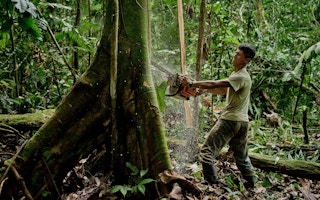At last November’s COP26 UN climate talks, governments and foundations pledged to invest $1.7 billion to help indigenous and local communities protect fast-vanishing tropical forests seen as crucial to protecting a stable climate and biodiversity.
That sum, for the period 2021-2025, represents a more than seven-fold increase from the roughly $46 million a year those communities receive now, according to the donors.
But getting big sums of much-needed cash to threatened frontline indigenous communities is proving a major headache, indigenous leaders and funders warned at a Skoll World Forum event this week that explored how to dismantle the roadblocks.
Problems range from overly complex application and audit processes to very short-term funding, tight restrictions on how the cash can be used, and frequent mismatches between what donors and communities want to achieve, they said.
Rukka Sombolinggi, secretary general of the Indigenous Peoples’ Alliance of the Archipelago (AMAN) in Indonesia, said she found complaints that indigenous people “lack capacity” to work in Western ways particularly frustrating.
“We do have the capacity. We’ve proved our capacity for millennia,” she said during the online discussion. “But it’s different capacity… than what is dictated by outsiders.”
Receipts from the rainforest
Solomé Lemma, the Ethiopia-born executive director of Thousand Currents, which funds social movements, said donors concerned about indigenous groups being unable to manage complicated grants may be looking in the wrong place.
Funders might do better to build up their own ability to work with communities, rather than always asking them to adapt. “There’s an opportunity for us to really rethink,” she said.
Sombolinggi said donor demands for what she calls “hyper-accountability” - such as requiring receipts for expenses incurred in the rainforest - often waste funds and time.
“
If we start everything with lack of trust, we are not going to go anywhere.
Rukka Sombolinggi, secretary general, Indigenous Peoples’ Alliance of the Archipelago
Her organisation works with an extremely remote indigenous group in Indonesia’s highlands, reachable by a two-week hike into the area, for example.
When outside donors demanded the original receipt for a $500 coffee grinder the community bought, members had to spend another $300 renting a motorbike to deliver the receipt on time.
Such rigid demands mean “we are not saving our brothers. We end up writing reports,” said Sombolinggi, herself a member of the Torajan people from the highlands of Sulawesi.
“If we start everything with lack of trust, we are not going to go anywhere,” she noted, saying her own organisation was content with receipts photographed and sent via smartphone.
Jennifer Corpuz, an indigenous lawyer from the Philippines and policy lead for Nia Tero, a US non-profit working with indigenous people and movements, said a growing number of donors are trying to ease their demands.
Some require less written documentation and are making funding more flexible, so that threatened indigenous leaders can, for instance, shift spending to a fund for legal defence or sanctuary, if needed.
Transparency v. risk
Being more flexible can be harder for donor governments facing tight rules of their own.
But Gillian Caldwell, chief climate officer for the US Agency for International Development, said many are starting to stick to a few key principles.
Those include asking for and incorporating feedback from funding recipients, cutting down on paperwork, being responsive to requests for help, and making sure most funding is provided as multi-year, unrestricted grants.
“That is the kind of support NGOs need,” especially those working to change broader systems, Caldwell said.
Funders should also be aware that channelling outside money to threatened indigenous and frontline communities can put some at greater risk, particularly if the names and addresses of recipients are published, she added.
There is a need to balance the safety and well-being of communities with demands for transparency, she noted.
As donors seek to scale up financial support dramatically to indigenous and other forest peoples - seen as the most effective guardians of nature - they should avoid forcing them to “reinvent themselves to fit our model”, Caldwell warned.
For instance, the usual indicators of progress - GDP or daily income per person - rarely work in indigenous settings, Corpuz said. Groups she works with fix their own, such as how much of their territory they can safely access each day.
As forest and biodiversity losses accelerate in many parts of the world and efforts to reverse them lag, funders need to take more risks to figure out how to deliver the billions needed to reshape community and forest protection, the experts said.
“The right approach and strategy right now is to move the money and learn as we move the money,” Lemma said.
Funding nature protection “at sizes and scales you never thought you would fund (is) what the moment requires”, she added.
This story was published with permission from Thomson Reuters Foundation, the charitable arm of Thomson Reuters, that covers humanitarian news, climate change, resilience, women’s rights, trafficking and property rights. Visit http://news.trust.org/climate.








